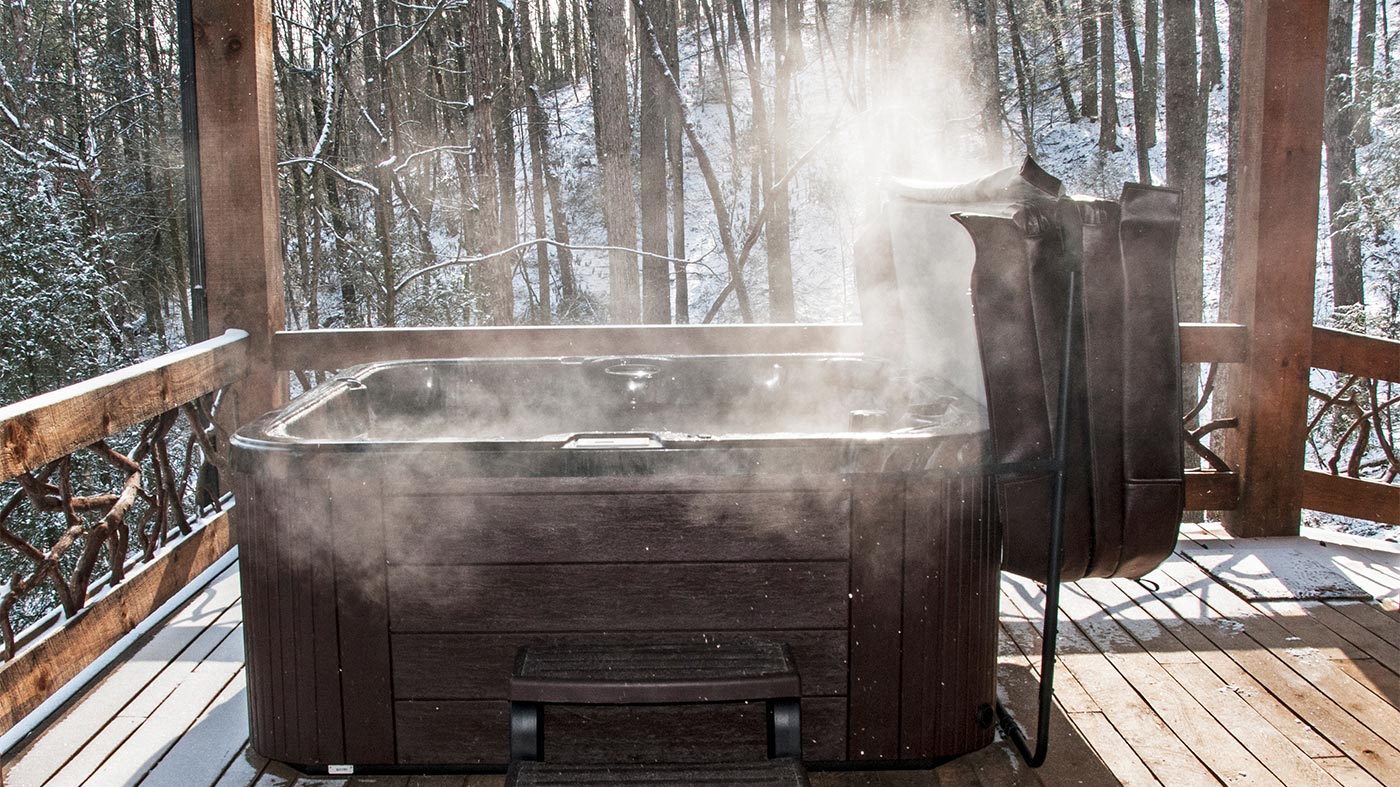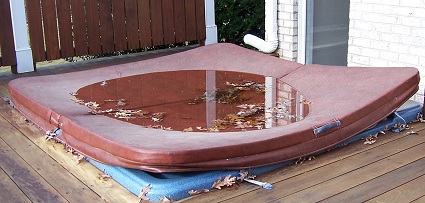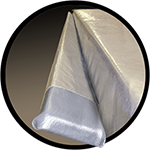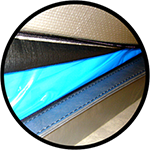Replacing Your Hot Tub Cover | Northern Hot Tub Covers®
20th Feb 2019

Knowing when to replace a hot tub cover can be tricky. While ordering a new hot tub cover costs hundreds of dollars, worn out covers often have so little insulating ability that they cost cost the same or more in added energy costs every year.
Today we will explore how you can tell when it’s time to replace your hot tub cover, what to look for in a replacement hot tub cover, and how to properly maintain your new cover to extend its lifespan.
How Do How Tub Covers Work?
Before we get too far into replacing hot tub covers, we thought we'd quickly cover how hot tub covers work in the first place.
Hot tub covers are essentially two large pieces of insulating foam covered first with a thin plastic vapour barrier and then in a thicker vinyl skin. The actual insulating is done by the foam. The vapour barrier then protects the foam from taking on water and the vinyl skin protects both from the UV of the Sun.
Why Do Hot Tub Covers Need To Be Replaced?
Over time, the various components that make up hot tubs covers will degrade; becoming less and less effective at insulating the water in the hot tub. As they become less effective, more heat is allowed to escape the hot tub and your heating costs increase. Eventually these increased heating costs outweigh the cost of replacing the cover and it only makes sense to replace the cover.
How Long Do Hot Tub Covers Last?
In general, hot tub covers have a lifespan of around 4-5 years. UV damage from the sun, falling debris (like tree branches or ice), heavy snow loads and user inflicted damage can all drastically reduce this lifespan however.
When Should You Replace Your Hot Tub Cover?
Heavy Covers
Most hot tub covers need to be replaced when their foam insulation becomes saturated with water.
Foam insulation works by trapping warm air within the bubbles of the foam. Since water is a poor insulator (water transfers heat 32 times faster than air), if those air bubbles fill with water the cover loses much of its insulating ability. This causes a dramatic increase in your monthly electric bill, especially in the winter.
How can you tell when a hot tub cover has become saturated with water? It will start to get heavy; in some cases heavy enough that the centre seam begins to split when you try to lift the cover. If not replaced the cover can even become too heavy for one person to lift.
“Cupped” Covers
Another sign that a hot tub cover needs to be replaced is if water starts to pool on it. This is a sure sign that the cover has begun to “cup”. Hot tub covers can start to cup when subjected to heavy loads – often either from snow loads or from people sitting on them – over long periods of time.
Cupped hot tub covers are a problem because they break the seal around the edge of the hot tub, allowing a substantial amount of steam and (more importantly) heat to escape. This leads to a higher energy bill, more water needing to be added (and heated), and more money spent on balancing chemicals.

If your hot tub has pools of water on it like this then it has begun to cup and should be replaced, even if the corners haven’t started to lift as bad as this hot tub.
Buying A New Hot Tub Cover
For most people, knowing what replacement cover to purchase for their hot tub can be tricky as most retailers offer many different options at many different price points.
Here are a few essential things you should look at when buying a new hot tub cover.
How Good Is The Stitching?
Poor stitching can result in the cover ripping, even under normal use. Look for heavy thread and multiple lines of stitching in the seams. Our stitching is reinforced with over 30 points of internal reinforcement at all high stress and problem areas, including our tear free handles.
How Thick Is The Foam?
When it comes to the thickness of the foam, the thicker the cover, the better it will insulate. Replacement covers can be anywhere from 3″-2″ thick up to 6″-4″ thick.
Thicker hot tub covers are also heavier though. This can be a problem if you use a cover lifter. Once thick hot tub covers become waterlogged they put a ton of stress on both the seam of the cover and the cover lifter. This leads to one of two things:
- The seam begins to rip and the cover is slowly torn into two pieces.
- If the seam is strong, the cover lifter can begin to bend and break.
For this reason, thicker covers usually don’t last quite as long as thinner covers will. The added insulating ability of the thicker cover can therefore negated by having to buy a new cover sooner. Overall, we’ve found that hot tub covers between 4″-3″ and 5″-4″ thick tend to be a good compromise between energy efficiency and lifespan.
Does The Cover Have A Northern Hinge?
A northern hinge (aka full foam sealer or baffle seal) is a piece of insulating foam that fills the area between the two sides of a hot tub cover. Without a northern hinge, your new hot tub cover will have a 1″ gap that is not insulated when the cover is closed, leading to a huge energy loss.
Northern hinges can be added to any one of our replacement hot tub covers for only $20, an investment that will save you hundreds of dollars over the life of the cover.

What Is The Thickness Of The Vapour Barrier?
As we previously mentioned, the vapour barrier is what stops water from absorbing into the cover’s insulating foam. Vapour barriers in replacement hot tub covers typically range in thickness from 3ml to 12ml. The thicker the vapour barrier, the better it will stop water from absorbing into the foam, and the longer it will last before deteriorating.

How To Extend Life Of Your Hot Tub Cover
Before we end this article, we thought we would share some of our top tips to help you extend the lifespan of your new hot tub cover.
- Use the hot tub cover’s built in clips to lock the cover down and form a better seal. This reduces the amount of heat loss and increases the energy efficiency of the hot tub!
- Don’t rest anything heavy on your hot tub cover. Heavy loads can cause your hot tub cover to cup over time. Remove any heavy loads of snow or ice in the winter and try to avoid sitting or placing anything on the cover.
- Don’t use shovels to remove snow from your hot tub cover as their blades can catch on the cover and tear open the vinyl skin and vapour barrier. Instead, use a brush like the ones used to remove snow from a car.
- Leave your cover fully open for at least 30 minutes after shocking your hot tub. After you shock your hot tub, strong chemical vapours are released that can harm the underside of the cover and increase the rate at which the vapour barrier deteriorates.
- Follow a basic hot tub cover maintenance schedule to keep the cover clean and protected.
Wrapping Up
With new hot tub covers costing hundreds of dollars, most people are hesitant to replace them. With an average of 30-40% of the heat loss in a hot tub coming from its cover however, the inefficiency of old, worn out covers can cost much more in the space of only a few winter months. Knowing when to replace your hot tub cover can save you hundreds if not thousands of dollars in energy bills over the life of your hot tub.
All replacement hot tub covers are not created equal, however. Before purchasing just any hot tub cover, you'll want to make sure that it is just as good, if not better than your original hot tub cover. In most cases, spending an extra $20-$30 now can save you hundreds of dollars over the life of your new hot tub cover.






